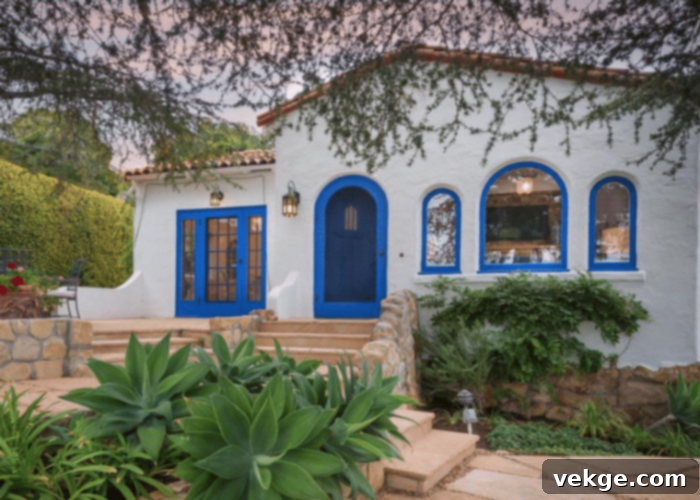Mastering the Palettes: A Comprehensive Guide to Spanish-Style Home Colors and Design
Do you find yourself captivated by the timeless charm of Spanish-style homes, or are you seeking inspiration for a vibrant and inviting color scheme for your own abode? Spanish Colonial architecture has profoundly influenced the home design landscape for centuries, leaving an indelible mark across various regions. Introduced to American soil in the 1600s and flourishing through the mid-1800s, particularly in sun-drenched areas like Florida, Los Angeles, California, and Arizona, this distinctive architectural style, with its rich history and aesthetic appeal, has remained a beloved choice.
But what truly defines a Spanish-style home, and how can you recognize its unique character? These captivating residences are easily identified by their harmonious blend of neutral and vibrant color schemes, the distinctive texture of stucco walls, graceful archways for doors and windows, and the iconic warmth of terracotta roof tiles. Beyond mere aesthetics, these elements tell a story of cultural heritage, practical design for warmer climates, and a deep connection to natural materials. This article delves deep into the heart of Spanish-style home design, exploring the quintessential color schemes adopted by Spanish architecture and revealing how these classic designs have been beautifully modernized over time, offering endless possibilities for your own home transformation.
Unveiling the Iconic Color Schemes of Spanish-Style Homes
The selection of colors in Spanish architecture is deeply rooted in both tradition and necessity. In Spain, buildings are frequently painted white, a practical choice that reflects the intense sun’s rays, effectively keeping interiors cool during scorching summers. However, the palette extends far beyond simple white, embracing a rich spectrum of warm, rustic tones such as earthy oranges, deep reds, and profound browns. Furthermore, many Spanish regions celebrate bold, expressive shades like vivid greens, serene blues, and majestic purples, often used to create striking contrasts and highlight architectural features. The ultimate color selection often hinges on its intended purpose, whether for cooling, cultural symbolism, or pure aesthetic preference. Below, we explore the primary color shades that grant Spanish-style homes their unique and unforgettable identity.
1. Traditional Hues: The Foundation of Spanish Charm
At the core of Spanish-style homes lies a commitment to traditional, earthy colors that evoke a sense of history and warmth. The exterior walls are typically finished with stucco plaster, a durable and breathable material made from cement, lime, sand, and water, known for its characteristic texture and ability to withstand the elements. This stucco serves as a perfect canvas for interior and exterior applications alike. Inside, the walls of a traditional Spanish-style home often embrace a comforting palette of beige, off-white, ivory, or pure white. These neutral shades create a serene backdrop, allowing other decorative elements to shine, while also contributing to a bright and airy atmosphere. Complementing these neutrals, deeper accents of deep yellow or rich rust tones are frequently incorporated, often in textiles, decorative tiles, or smaller architectural details, adding depth and a touch of sun-baked warmth to the overall design. This combination forms the backbone of the classic Spanish aesthetic, providing a versatile foundation for various design choices.
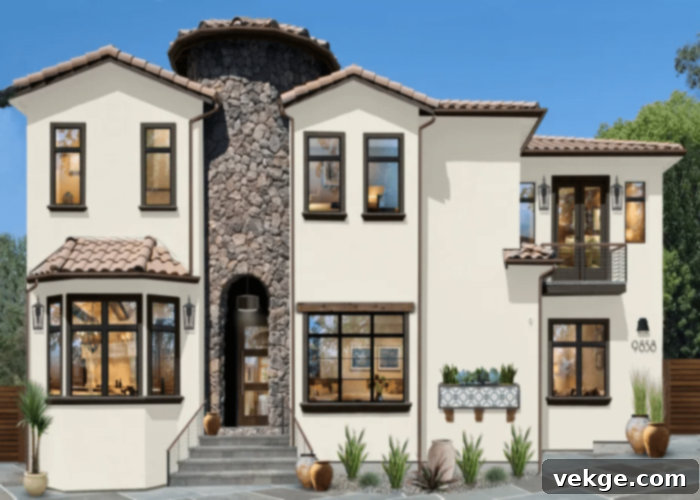
2. The Alluring Blue Hue: A Splash of Serenity
A fascinating aspect of Spanish folklore suggests, “Add a splash of blue to keep evil away!” This charming saying has contributed to the popularity of blue in Spanish homes, particularly for exterior elements. What began as a playful notion evolved into a widespread trend, as homeowners discovered the undeniable appeal of a bright blue door or window trim. This vivid “Azul” creates a striking contrast against the often-monochromatic stucco walls, instantly breaking monotony and infusing the facade with personality and a sense of freshness. Beyond folklore, blue carries a psychological resonance, evoking the clear skies and tranquil Mediterranean waters. You can strategically incorporate bold blue not only on doors but also on window trims, decorative panels, ceramic tiles, or even as an accent color in textiles and furnishings. Its versatility allows it to be both a subtle highlight and a dramatic statement, bringing a touch of coastal calm or vibrant energy to any Spanish-style space.
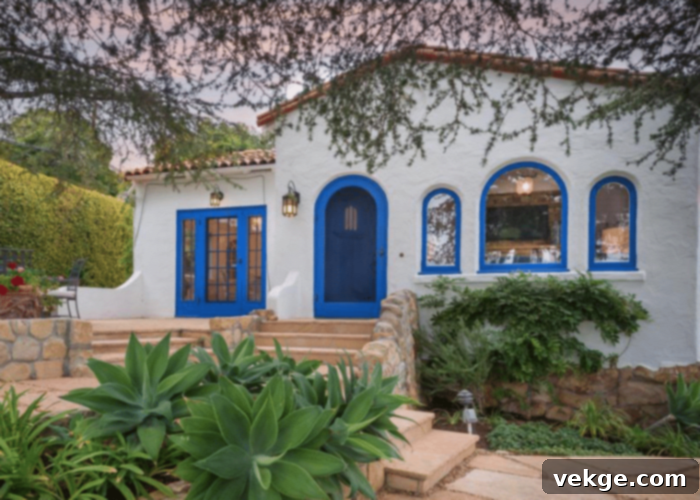
3. A Pop of Bold: Embracing Vibrant Expressions
Spanish design is renowned for its fearless use of color, reflecting a culture rich in artistry and celebration. Beyond the traditional neutrals and serene blues, a Spanish-style home is the perfect canvas for a pop of bold and energetic colors. Imagine rich emerald greens, regal purples, deep maroons, or fiery vermillion, strategically placed to create impactful visual statements. Many regions throughout Spain are dotted with buildings painted in these captivating, vibrant hues, showcasing a joyful departure from muted palettes. The beauty lies in their application; you don’t necessarily need to paint an entire building bright green or red. Instead, these bold colors can be brilliantly employed to accent architectural features. Consider painting window trims or panels in a striking shade, incorporating vibrant mosaic tile flooring in a patio or entryway, or using richly colored textiles and pottery to inject personality into interior spaces. These carefully chosen bold accents create focal points, add depth, and imbue your Spanish-style home with an authentic sense of warmth and spirited character.
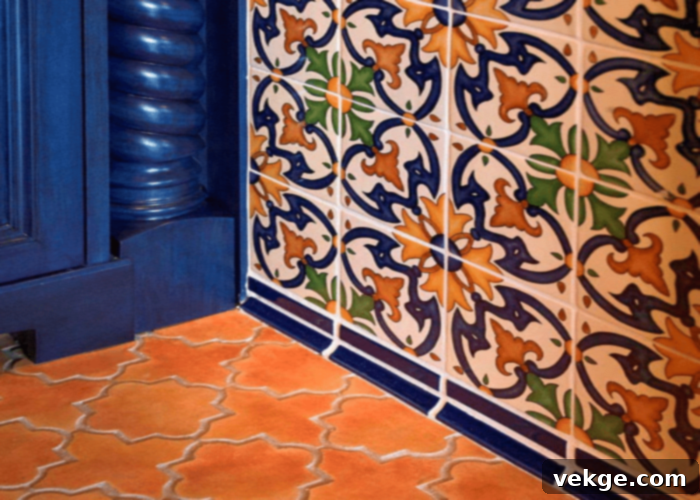
4. Rustic Tones: The Warmth of Earth and Sun
The rustic color palette is indispensable to Spanish-style homes, instantly conjuring feelings of warmth, history, and inviting coziness. These colors are directly inspired by the natural landscape of Spain – the sun-baked earth, clay, and ancient stone. Key rustic shades include rich reds, sun-drenched oranges, and deep, grounding browns. For decades, these tones have been integral to Spanish architecture, most notably exemplified by the iconic red roof tiles that are often the first thing to catch your eye when you spot a Spanish-style home. This terracotta hue isn’t just a color; it’s a material, a tradition, and a symbol of durability. Beyond the roof, rustic tones are incorporated into stucco washes, natural wood beams, stone accents, and interior decor. Imagine an inviting living room with terracotta-colored walls, dark wood furnishings, and accents of burnt orange or deep ochre. These colors create an atmosphere that feels both robust and comforting, seamlessly connecting the home to its natural surroundings and heritage.
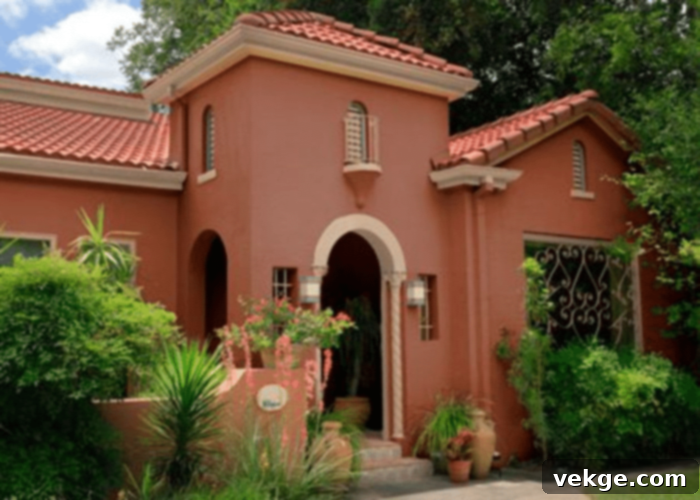
Selecting the Perfect Palette: Your Guide to Spanish-Style Home Colors
Embarking on the journey to select the ideal color palette for your Spanish-style home might initially seem like a monumental task, but it doesn’t have to be. The key lies in understanding the interplay between traditional elements and personal preference. A winning strategy involves pairing classic neutral colors such as tan, beige, cream, and white with richer, earthy tones like terracotta, reddish-brown, burnt orange, and deep olive green. This balance ensures your home exudes authenticity while allowing for personalized touches. Consider your home’s natural light, its geographical location, and the overall mood you wish to create. By thoughtfully combining these elements, you can achieve a harmonious and breathtaking Spanish-inspired aesthetic. Let’s explore how to choose colors for specific architectural components.
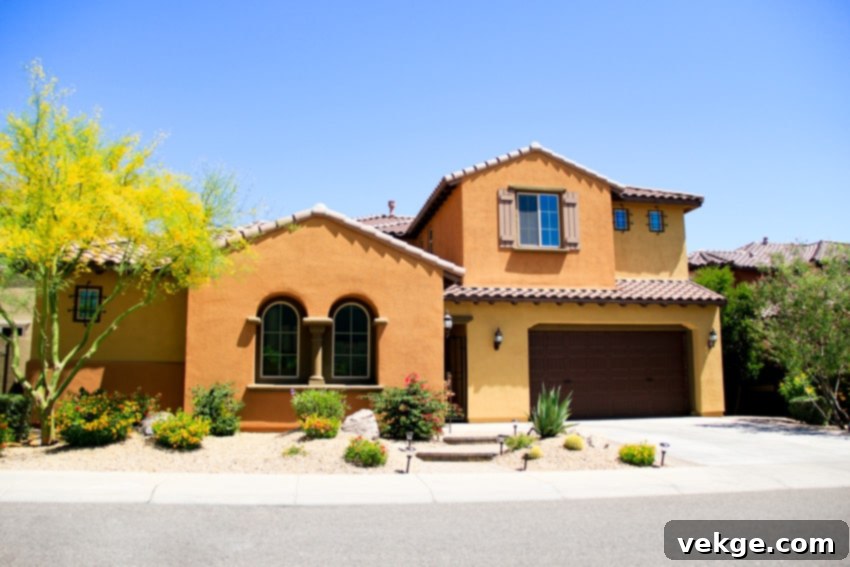
1. The Roof: Defining the Skyline
The roof of a Spanish-style home is arguably its most defining feature, characterized by the iconic “Barrel tile Roofing,” also known as mission or pan tiles. These ceramic tiles, celebrated for their distinctive curved design and exceptional durability, lend a unique contoured appearance to the rooftop. Traditionally, these tiles were predominantly red or a rich, earthy orange, a color derived naturally from the clay they were made from. Over the decades, while the classic terracotta remains immensely popular, the color scheme has subtly expanded to include variations of deep brown, charcoal black-brown, or nuanced reddish-browns. These darker tones offer a sophisticated alternative while still complementing the overall Spanish aesthetic. When selecting roof colors, consider how they will harmonize with your stucco walls and the natural landscape, as the roof often sets the tone for the entire exterior palette.
2. The Ceiling: Elevating Interior Ambiance
Within most Spanish-style homes, the ceiling plays a crucial role in balancing the visual weight of often vibrant flooring and robust wall treatments. To achieve this harmony, light shades are overwhelmingly favored for ceilings, creating an expansive and airy feel. Shades like off-white, crisp white, warm ivory, or soft cream are excellent choices, as they seamlessly complement traditional dark wood flooring and boldly colored walls. These light ceilings reflect natural light, making spaces feel larger and brighter. Many authentic Spanish-style homes further enhance this design by featuring plain white ceilings interspersed with exposed dark wood beams. These beams add a rustic, architectural detail, introducing warmth and texture without overwhelming the space, and providing a beautiful contrast against the serene backdrop of the light ceiling.
3. The Walls: Canvas of Character
The walls are perhaps the most significant canvas in a Spanish-style home, both inside and out. Traditionally, rough-textured stucco exterior walls, crafted from a robust mixture of sand, lime, plaster, and water, have been the hallmark. Stucco is not just a finish; it’s a structural and aesthetic element that defines the home’s character, offering excellent insulation and a classic, sun-drenched appearance. While many homeowners opt to leave the exterior stucco in its natural, warm white or beige tone, others choose to introduce additional paint. In Spain, it’s common to see buildings in various regions adorned in bright reds, ochres, or other vibrant colors, making a bold statement. For interior walls, the options expand from soft neutrals like off-white and cream to rich, earthy tones or even dramatic accent walls in deep blues, greens, or terracotta. The choice of wall color dictates the mood of each room, from tranquil retreats to lively gathering spaces.
4. The Flooring: Grounding the Design
The flooring in Spanish-style homes is a testament to natural materials and artisan craftsmanship, often serving as a vibrant focal point. Historically, these homes featured floors made from durable clay, terracotta, or natural stone, meticulously laid by hand. These materials were not only sturdy and long-lasting but also naturally cool underfoot, a significant advantage in warm climates. The original designs frequently boasted intricate motifs and patterns on brightly colored tiles, such as Talavera or Saltillo, which added immense vibrancy and artistic flair to each room. Today, you have the elegant choice between these traditional mosaic tiles, which can be strategically placed in entryways, kitchens, or bathrooms, or the timeless appeal of wooden flooring. Dark, rich woods like walnut, mahogany, or distressed oak are often chosen for living areas and bedrooms, providing warmth and a sophisticated contrast to lighter walls and colorful accents. Combining these flooring options can create dynamic and inviting spaces.
5. Window Panels and Trims: Framing the View
The window panels and trims in Spanish-style homes are typically flat, simple, and robust, designed to offer both aesthetic appeal and practical shade. These elements frame the views and contribute significantly to the home’s exterior character. Traditionally, these panels were often rendered in natural wood tones—rich browns, warm terracotta, or other desert-inspired hues that complemented the stucco walls and roof tiles. These colors helped to create a cohesive, earthy look. However, contemporary homeowners and designers are increasingly embracing bold shades for these features. Vibrant blues, deep greens, or striking reds are now popular choices, offering a powerful contrast that makes windows pop and adds an unexpected layer of color to the facade. Choosing a bold color for your window trims or shutters can dramatically enhance your home’s curb appeal and inject a modern twist into a classic design.
6. Stone Walls: Texture and Timelessness
Beyond stucco, stone walls play a crucial role in authentic Spanish-style architecture, especially for exterior features, retaining walls, or accent sections. These natural stone elements, often combined with stucco plaster, contribute a unique texture and rugged beauty to the house’s exterior. The colors of the stone walls are typically subtle and organic, ranging from cool grays and creams to warm ochres and browns, depending on the local stone available. This natural material helps to add coolness to the house, making it particularly comfortable during hot summer months. Stone also introduces a sense of permanence and opulence, enhancing the luxurious and historical aesthetic of the home. Whether used for a prominent facade, a courtyard wall, or an interior fireplace, stone walls provide a tactile dimension and a timeless appeal that grounds the entire design.
Conclusion: Crafting Your Personal Spanish Oasis
The Spanish Colonial design has endured as a favored style for both decorators and homeowners, largely due to its subtle elegance, classic characteristics, and inherent warmth. Spanish-style homes effortlessly blend a touch of sophistication with minimal embellishments, relying on the inherent beauty of smooth stucco, the rustic charm of terracotta tiles, and the architectural grace of arched doors and windows. These elements come together to create spaces that are both grand and inviting.
Ultimately, your home is your personal canvas, and how you choose to decorate it should reflect your unique taste, budget, locality, and lifestyle. While the rich traditions of Spanish design offer a bountiful source of inspiration, don’t feel confined to solely simple, neutral hues. Embrace the spirit of Spanish artistry by incorporating bold colors and vibrant accents where they feel right. Experiment with deep blues, rich greens, or fiery reds in your textiles, pottery, or accent features to inject personality and a contemporary flair into your classic Spanish-style home. By understanding the foundational elements and allowing yourself creative freedom, you can craft a home that is not only beautiful but truly a reflection of you, blending timeless tradition with modern vitality.
